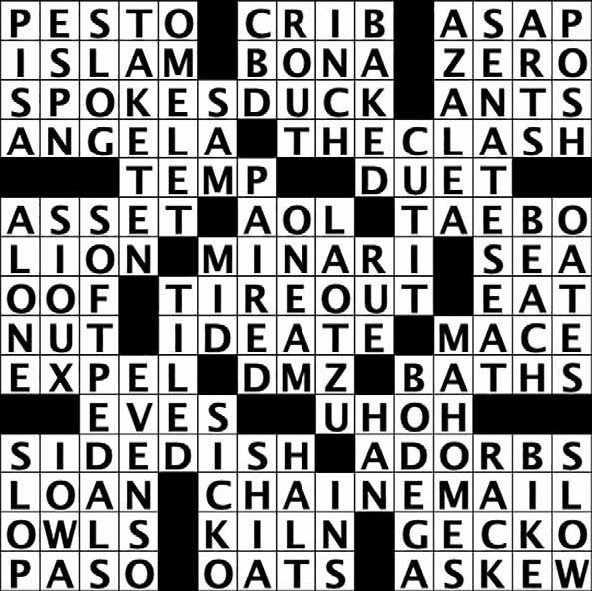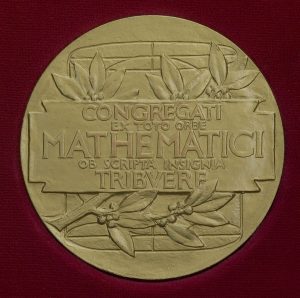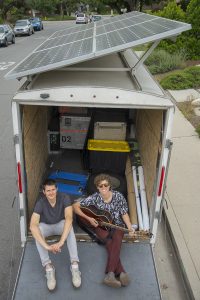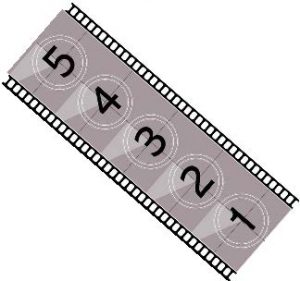Page 1
Panel 1
Caption: Our Bird’s Beginnings. Story by Robyn Norwood, Illustrated by Eric Melgosa
Image: Cecil stands by a mailbox preparing to send a DNA test kit.
Cecil (thinks): All right! Time to find out where I come from…
Panel 2
Caption: Adan Amaya, Pomona College Mail Services, finds Cecil training in preparation for “Through the Gates.”
Image: Listening to music through his headphones, Cecil leans against the Pomona College gate stretching his knee as it goes “CRUNCH.” Adan has a package in his hand.
Cecil (singing): …turns out I’m 100% that…
Adan: Hi Cecil! I’ve got a package for you.
Cecil: Oh, Hey Adan! That’s probably my DNA results. I’m so nervous!
Panel 3
Image: As Adan holds a sheet of paper with Cecil’s DNA test results, Cecil asks…
Cecil: What’s it say, Adan?
Adan: hmm, let’s see… I’m Sorry, Cecil, it says you’re not human. You have way more than 46 chromosomes so they cannot process your DNA.
Panel 4
Image: Cecil dejectedly walks up to the entrance of the Richard C. Seaver Biology Building.
Cecil (thinks): What in the world am I!? Prof. Karnovsky will know what to do. If anyone can figure this out, she can!
Page 2
Panel 1
Image: Open panel showing Professor of Biology Nina Karnovsky and Cecil in conversation.
Cecil: Prof. Karnovsky, I need your help! The DNA test I took didn’t work! Is there a “23 and poultry” or something!?
Prof. Karnovsky: Well, Cecil, I don’t think that will give you the answers you’re looking for. Who you are is a lot more than your DNA, you know. I think you should go see Sean Stanley, the College archivist, You might find some hidden heirlooms!
Panel 2
Image: Overhead view of Prof. Karnovsky and Cecil looking at photos, documents and a range map of the Greater Sage Grouse.
Prof. Karnovsky: Before you go, come look at these pictures. Here we have Centrocercus urophasianus, the Greater Sage Grouse, also known as a sagehen.
Cecil: …But they’re brown. I’m blue. And my beak is orange. I definitely don’t have those pectorals.
Prof. Karnovsky: Those aren’t pectorals. They’re air-filled sacs used in courtship displays. Those spiky tail feathers are another way the males try to attract a mate. And sorry to say, but they don’t chirp. It’s more of a coo-coo, plus a bubbling or popping sound.
Page 3
Panel 1
Caption: First thing the following day, Cecil visits the college archivist, Sean Stanley, to find out what he knows about Cecil’s origins.
Image: Sean stands behind a counter as Cecil greets him.
Sean: Ah, Early bird gets the worm. Hi Cecil!
Image: Cecil imagines himself with a mouth full of worms with a nauseated look on his face.
Cecil: That’s disgusting!
Sean: Never mind. I have something I think you’d like to see.
Panel 2
Image: Sean holds out a pennant depicting a slim anthropomorphic bird wearing a two-toned cap followed by the word Pomona.
Cecil: Who’s that supposed to be?
Panel 3
Cecil: Do you think that’s my father?
Image: Cecil imagines the old mascot wearing a black Stahlhelm claiming to be his father.
Sean: No, no. This pennant is estimated to be from the 1930s or ’40s. That would be many hen-erations ago.
Image: Sean holds up a blue and white cap with a small rim on it.
Cecil: OK, smart aleck! But he’s so… thin. Scrawny. He looks nothing like the Greater Sage Grouse. What’s that hat, anyway?
Panel 4
Sean: There was a tradition that first-year Pomona students had to wear a blue beanie with a P on the front. They say that ended with the Great Freshman Beanie Revolt of 1967.
Image: A crowd of students gathers in front of Sumner Hall holding picket signs that say BEANIE REVOLT.
Cecil: The ’60s. I thought the protests were about more important things.
Sean: They generally were. So back to the origins of the Sagehens…
Page 4
Panel 1
Sean: In the early 1900s, Pomona’s athletic teams were called various nicknames, including Huns, once a reference to warrior nomads but later an unfortunate pejorative term for Germans during World War I and World War II. Though Sage Hens appeared in the L.A. Times as early as 1911, according to one legend a writer for The Student Life in 1913 might have meant to type Huns but typed Hens, and it stuck.
Image: Sean and Cecil, in conversation, both imagine a group of nomadic warriors on horseback wielding bows and arrows, pikes and swords.
Cecil: So I’m a Typo?!
Sean: If you are, you’re a typo with staying power. Since 1918, the Sagehen has been the only symbol of Pomona, Pomona-Claremont and now Pomona-Pitzer athletics. Have you been to see Miriam Merrill, our athletics director? She may have useful perspective.
Cecil: No, but that’s a good idea. I’ll go see her now.
Panel 2
Image: Cecil waves at Miriam Merrill, the director of Pomona-Pitzer Athletics.
Miriam: If it isn’t our 2021 national champion Sagehen!
Cecil: Yes! men’s cross country and men’s water polo!
Miriam: You’re really something, Cecil.
Cecil: Thanks, Miriam … But who am I really?
Miriam: You’re the spirit of the college, Cecil. You are one of a kind!
The End

 Hidden figures no more. That’s the future that Professor of Mathematics Ami Radunskaya hopes to see soon in the world of mathematics: more women—particularly more women of color—in the field.
Hidden figures no more. That’s the future that Professor of Mathematics Ami Radunskaya hopes to see soon in the world of mathematics: more women—particularly more women of color—in the field. A solar-powered Coachella? That’s a future that alternative rocker Skylar Funk ’10 hopes to see one day. Although there isn’t a solar generator that is big enough to power the Coachella main stage yet—things are moving in that direction, says Funk.
A solar-powered Coachella? That’s a future that alternative rocker Skylar Funk ’10 hopes to see one day. Although there isn’t a solar generator that is big enough to power the Coachella main stage yet—things are moving in that direction, says Funk. Sales of the Japanese graphic novels and comic books known as manga have been falling inside Japan itself since the mid 1990s—a fact that Carl Horn ’91, manga editor for Dark Horse Comics, attributes to the long decline in the nation’s population—especially at the young end of the spectrum. “Even though Japan has the deserved reputation as a country where adults read comics, the top-selling titles are your Dragon Balls, your Narutos, your One Pieces, your Attack on Titans,” Horn says. “In other words, manga that were made for younger readers.”
Sales of the Japanese graphic novels and comic books known as manga have been falling inside Japan itself since the mid 1990s—a fact that Carl Horn ’91, manga editor for Dark Horse Comics, attributes to the long decline in the nation’s population—especially at the young end of the spectrum. “Even though Japan has the deserved reputation as a country where adults read comics, the top-selling titles are your Dragon Balls, your Narutos, your One Pieces, your Attack on Titans,” Horn says. “In other words, manga that were made for younger readers.” She’s smart. She’s funny. She’s a 20-something-year-old Saudi woman growing up on the Moon. That’s Jazz Bashara, the protagonist of Andy Weir’s newest sci-fi book, Artemis, and a soon-to-be-made feature film by producer Aditya Sood ’97.
She’s smart. She’s funny. She’s a 20-something-year-old Saudi woman growing up on the Moon. That’s Jazz Bashara, the protagonist of Andy Weir’s newest sci-fi book, Artemis, and a soon-to-be-made feature film by producer Aditya Sood ’97. In films, they’re famously known as continuity errors. But these annoying little bloopers also creep into novels. For example, in J.K. Rowling’s Harry Potter and the Prisoner of Azkaban, a griffin first seen tied to a tree later finds itself tied to a fence.
In films, they’re famously known as continuity errors. But these annoying little bloopers also creep into novels. For example, in J.K. Rowling’s Harry Potter and the Prisoner of Azkaban, a griffin first seen tied to a tree later finds itself tied to a fence.